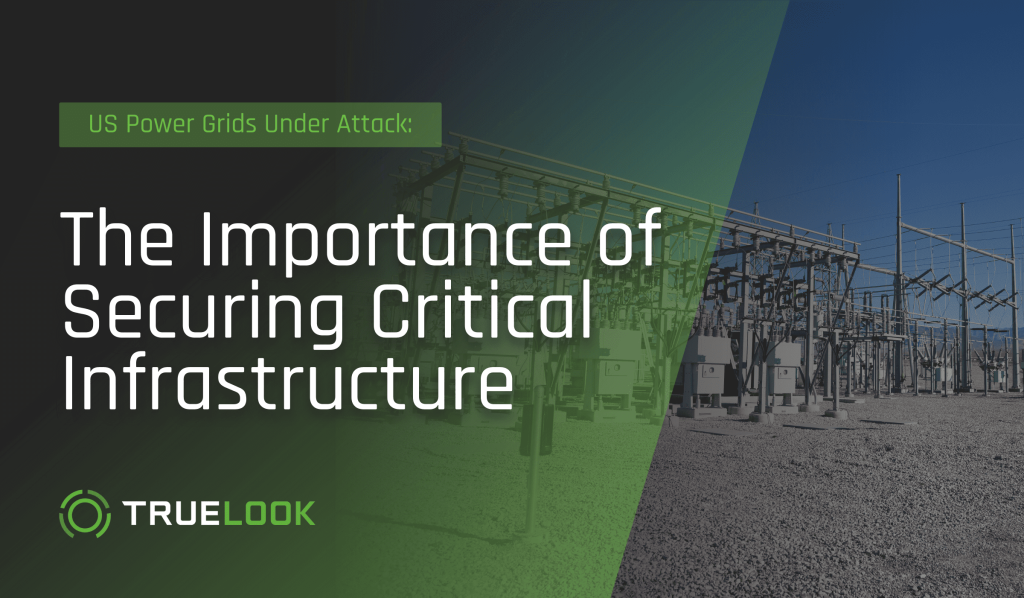The last decade has brought an unprecedented surge in attacks on U.S. critical infrastructure through vandalism, theft, and, more recently, cyber terrorism. As economic, political, and social infrastructures increasingly digitize, power grid attacks and potential consequences on connectivity are becoming a more significant, imminent threat.

A story from 2024 saw authorities arrest a Neo-Nazi group leader in connection with planned sniper attacks aimed at the Maryland power grid. Shootings at North Carolina power stations and a Christmas Day attack on energy substations further highlight the risk of critical infrastructure for millions of people.
In this article, we’ll delve into the rising threat of infrastructure attacks, explore the vulnerabilities of our power grid, and examine the critical role of advanced security measures in safeguarding these essential systems.
What are Infrastructure Attacks?
Attacks on critical infrastructure continue to evolve, and understanding their nature is vital for national security. Infrastructure attacks are both physical assaults on facilities and sophisticated cyber attacks targeting control systems. Each type of attack poses unique challenges for infrastructure security agencies, critical infrastructure construction companies, and owners.
Physical attacks include vandalism, sabotage of equipment, and armed assaults on facilities like power substations or water treatment plants. Cyber threats range from ransomware attacks that lock critical infrastructure systems to distributed denial-of-service (DDoS) attacks that overwhelm networks. They even include sophisticated malware attacks designed to gain unauthorized access to industrial control systems.
The impact of successful attacks on critical infrastructure can be devastating to American citizens and public health. Power outages affecting thousands, disrupted water supply systems, compromised patient care, and exposure of sensitive data can cause widespread chaos while potentially yielding financial gain for cybercriminals or advancing nation-states’ interests.
Why Do Critical Infrastructure Attacks Happen?
Government agencies have acknowledged that individuals and groups engage in these kinds of attacks for several reasons. In some cases, these are simply acts of vandalism and destructive behavior that result in unfortunate consequences. However, there are also more deliberate and complex motivations at play.
In recent years, domestic extremists have started to target power grids to cause civil unrest. Several suspected perpetrators with ideological motivations have faced charges after plotting to take down critical substations using both physical means and malicious code. These attacks highlight the evolving threat landscape facing critical infrastructure security.
These incidents reveal the vulnerability of current infrastructure systems and the persistent access bad actors can gain. Even common incidents like phishing emails that compromise login credentials showcase how malicious software can provide threat actors with complete control of programmable logic controllers and other sensitive components of infrastructure systems.
Increasing Attacks on the Power Grid
Despite robust cybersecurity measures implemented by critical infrastructure owners and government agencies, attacks on power grids have risen over the last decade. Security experts warn that infrastructure systems face increasingly sophisticated threats from malicious actors who seek to disrupt operations and compromise national security.
The frequency of cyber threats and physical attacks targeting electrical substations introduces unprecedented challenges for the cybersecurity and infrastructure security community. Recent incidents like the North Carolina substation shootings and attacks on Tacoma Public Utilities demonstrate how vulnerable these systems remain.
Supply chain attacks also represent a growing concern as they allow hackers to infiltrate multiple infrastructure systems simultaneously, even through trusted channels. During a meeting with the Federal Energy Regulatory Commission (FERC) on critical infrastructure security, industry leaders warned that the threat landscape continues to evolve at an alarming pace.
The CEO of the North American Electric Reliability Corporation’s Electricity Information Sharing and Analysis Center, Manny Cancel, shared his concern for the security of critical infrastructure. He warned that recent threats to power grid infrastructure and elements of the electricity supply chain are increasing “not only in complexity but in volume” and attribute to the “most complex threat landscape” he has seen in his tenure.
Cybercriminals use malicious software to gain access to industrial control systems that manage power distribution networks across the nation.
Phishing attacks and spear phishing campaigns targeting the IT networks of utility companies continue to provide cyber criminals with login credentials and potential full control of critical systems. Even when these attacks don’t immediately disrupt the power supply, they often establish persistent access that allows hackers to collect information and potentially deploy malicious code in future operations.
The Government’s Response to Infrastructure Attacks
As the federal government plans to expand and update power grids across the country, especially for new renewable energy such as wind and solar, the increased numbers of power centers and substations will inevitably bring the risk of potential targets. With the potential increase of power grid attacks, the federal government has taken broader steps in securing the ever-expanding national infrastructure.
The U.S. Department of Energy (DOE) warned in its October report that distributed energy resources bring “emerging cybersecurity challenges to the electric grid” and should subsequently focus on security as “a core component.”
Growing Concerns About Smaller Facilities
Currently, federal cybersecurity regulations mainly focus on major substations and transformers. Basically, the critical infrastructures that connect thousands and tens of thousands of families to the power grid for everyday life.
Coordinated attacks on these vulnerable facilities have the potential to cause widespread outages. The risks mean that these facilities have strict regulations for securing their infrastructures, from armed security staff to bullet-resistant fencing and video monitoring.
Smaller facilities, however, such as those targeted in Moore County, do not have the same regulations and often do not meet the federal criteria for security. Instead, they are at the mercy of state and local regulations, which can vary wildly.
These regulations are critical for securing valuable public infrastructure and equipment, as well as for keeping suburban, rural, and metropolitan areas online and lit. While needed security measures can vary according to size, location, and population, it is more important than ever to stay proactive and vigilant in securing and protecting today’s critical infrastructures.
How to Deter Infrastructure Attacks
TrueLook proudly calls headquarters home in Winston-Salem, North Carolina, so the power grid attacks are a concern that truly hits close to home. As an industry leader in construction cameras, security through remote jobsite monitoring and connectivity are hallmarks in how we serve our customers and community.
Here are key defensive measures that organizations should prioritize to protect vital systems and services:
- Remote Jobsite Observation: Jobsite cameras enable real-time remote observation of the site from anywhere with an internet connection. This allows security personnel and site managers to monitor activities, identify potential threats, and respond quickly to incidents without physically being on-site.
- Live Professional Monitoring: TrueLook’s live monitoring teams actively watch the site after hours, providing an extra layer of security. They can identify suspicious activity, contact authorities, and even use talk-down features to deter intruders.
- Proactive Deterrence with Strobes and Sirens: TrueLook’s security solutions, like TrueShield and TrueDeter, utilize highly visible strobe lights and loud sirens to deter criminals. These immediate, attention-grabbing responses create a strong deterrent, often preventing incidents before they occur.
- High-Quality Video Evidence: TrueLook Cameras capture high-resolution video footage, providing valuable evidence in the event of a security breach. This footage can be used to identify suspects, track their movements, and support investigations.
- Cybersecurity: Robust cybersecurity measures, including next-generation firewalls, intrusion detection systems, and regular security updates, help prevent ransomware attacks and other cyber threats that target industrial control systems through vulnerable IT networks.
- Vulnerability Assessments: Regular security assessments help identify potential weaknesses in physical and digital infrastructure systems. Perform these evaluations before criminals and vandals can exploit them to gain unauthorized access or deploy malicious code.
- Redundancy and Backup Systems: Implement redundant infrastructure components and secure backup systems to ensure critical operations continue. These systems mitigate the impact of attacks on primary control systems, minimizing disruption to essential services.
We understand that security is always a number-one priority, no matter the size or location. From small contract work to large-scale infrastructure, TrueLook Cameras are keeping watch to ensure security for all customers and the communities their projects serve. To find out more about TrueLook, check out our website for a full feature list of our construction camera fleet, contact us to schedule a live demo, or read our blog for more industry news and insights.
Secure Your Critical Infrastructure with TrueLook
Cyber threats and physical attacks on critical infrastructure aren’t going anywhere. Only with vigilance from government officials, private owners, the cybersecurity community, and construction companies can such infrastructure remain secure against malign forces.
Every American citizen has a stake in ensuring our critical infrastructure systems remain resilient against those who seek to disrupt operations and compromise national security.
Ready to strengthen your infrastructure security? Schedule a consultation with a TrueLook security expert today to discover how our advanced monitoring solutions can help detect threats before they gain unauthorized access to your critical facilities.

